Living in Tarija
A Global Village Team Experience in Bolivia
By Susi Havens-Bezaire
(Click photos to see full size)
I hope that this brief overview will help leaders of other teams selected to work with the Tarija affiliate.
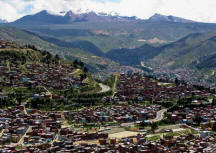
Photo by Susi Havens-Bezaire
Getting to Tarija
Tarija, near the southern border with Argentina, is an agricultural area well suited for grape and wine production. Founded in 1576, it still centers on many pleasant, traditional plazas scattered around the city. Other attractions include several parks, waterfalls, caves, and the world-renowned Paleontology Museum of Tarija City.
Tarija is the 7th largest city in Bolivia with about 170,000 inhabitants, and also the name of the 6th largest department (state) with a population of 470,000. It is frequently referred to by citizens and travelers alike as "the best kept secret of Bolivia". Perhaps part of its charm is proportional to the difficulty in getting there—most people fly into Tarija.
Our team met in the La Paz airport, to travel together on Aerosur Airlines to Tarija. It's important to note that Aerosur is one of the few airlines that still requires paper tickets—and demands that team members produce them! The airport is actually a half-hour from La Paz in El Alto and is at an elevation of 13,313 ft. Most team members experienced some level of altitude sickness, but all recovered within a few hours.
Those team members who arrived early into La Paz stayed at the Hotel Rosario http://www.hotelrosario.com/la-paz/content/blogcategory/15/28/lang,en/http://www.hotelrosario.com/la-paz/content/blogcategory/15/28/lang,en/ The Hotel Rosario is centrally located, within walking distance of many markets and museums, and has wonderful English speaking staff who were very helpful to our team members. We also spent our 2 days of R & R in La Paz and returned to this hotel a few more times during extended travel. They had a great breakfast, kept extra luggage while we traveled, and offered a discount for being a Habitat team!
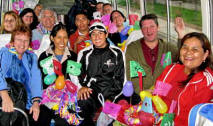
Photo by Susi Havens-Bezaire
Living in Tarija
Tarija was a great city for a GV team to live and work. We were met at the airport by the HFH staff, volunteers and families with a very warm welcome and escorted to Hostel Carmen, our hotel for the next 2 weeks.
Hostel Carmen is within walking distance of 3 of the beautiful plazas in Tarija.
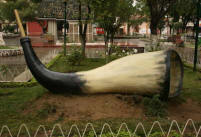
Photo by Kerry Cheesman
Team members felt very safe walking in the day or evening amongst the friendly and curious (we did appear to be the only "strangers" around) people we met. Our team celebrated the hot showers, accommodating staff and relatively quiet street that the hostel was on. Yet, we were close to many internet cafes and restaurants. One night, we feasted on local fish at Freddie's restaurant—2 blocks away.

Photo by Dave Bezaire
Paulino, our bus driver, was always on time and a very conscious driver. It would take about 20 minutes to wind our way through the many one-way, narrow streets to reach the barrio we were working in.
The HFH Tarija affiliate and Escarlem, our GV Bolivia contact, provided the team with a fantastic orientation—even printed house plans and helpful resource of pictures of tools identified in spanish were included! We made many friends while working with local volunteers, staff and families.
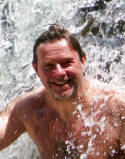
Photo by Susi Havens-Bezaire
R & R in and around Tarija
The team spent a Sunday traveling to a beautiful preserve that included a short hike to a wonderful series of waterfalls, that some team members braved the cool waters.
In the afternoon, we headed to the Ville de la Conception winery, to enjoy music, local dances and a plentiful meal.
We also had two evenings with a cooking exchange with the staff and families. We tasted Tarija's famous saisi and the team cooked chili, corn bread and apple pie another night. It was a fun challenge finding the ingredients in the Central market.
Some team members enjoyed the tour of the Paleontology museum in town before our departure back toLa Paz.
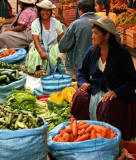
Photo by Kerry Cheesman
R & R in La Paz
We began our exploration of La Paz with an urban trek through the city provided by La Paz on Foot. http://lapazonfoot.com/ La Paz on Foot is a scientific tourism and environmental education project dedicated to increasing awareness of the cultural and ecological history of La Paz and surrounding areas. We split the team into 2 groups, so that all members could hear the English speaking biologists that accompanied each group.
Stephen Taranto, the owner, also arranged an English speaking guide to accompany our team to the MUSEF museum, which is actually 4 museums in one. All the team members really liked both aspects of this tour.
There were many restaurants and small tourist shops within walking distance of the Hotel Rosario that we enjoyed. On Sunday, many team members toured the major archeological site Tiwanaku. The full day tour also provided a great opportunity to see the difficulty of farming of the Altiplano Region, located between two major mountain ranges in Bolivia.
Extended travel in Bolivia
Bolivia has a very diverse topography and we invited team members to join us in exploring two very special, but different areas of Bolivia.
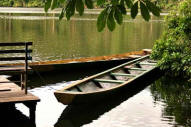
Photo by Kerry Cheesman
Madidi National Park in the Amazon Basin
We flew from La Paz to the frontier town of Rurrenabaque, which is the trickiest part of this journey. It is recommended that you add an extra travel day, in case the Rurrenabaque airport (a dirt strip) is not open. We stayed overnight at the town and the next morning hopped in a boat for a 5 hour boat ride up one of the Amazon tributaries.
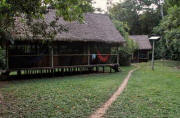
Photo by Dave Bezaire
We stayed at La Chalalan, an indigenous ecolodge that is providing community development for San Jose de Uchupiamonas population. Our team had a great time learning and exploring the park, both by day and night, with two English speaking naturalists. The spring fed lake to swim in was a great plus at the end of our long walks.

Photo by Dave Bezaire
Lake Titicaca in the Andes mountains
Our tour of this region was arranged by America Tours americatoursbolivia@entelnet.bo
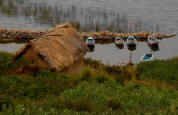
Photo by Dave Bezaire
César Renjel, cerenjel@gmail.com, from La Paz, our great English speaking guide, provided us with the history of the pre-Inca civilization, the culture of the indigenous communities we visited and he had vast knowledge about the nature of the area, current politics and social problems of his country. Note: it was good to have an extra day to acclimate in La Paz before heading up to the higher elevations at Lake Titicaca.
We stayed at Hotel La Cupula in Copacabana—a lake shore frontier town filled with tourist from all over the world. The beds were warm and comfy and the views were great. http://www.hotelcupula.com/
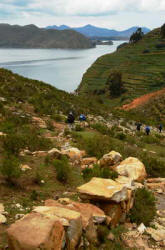
Photo by Dave Bezaire
We then traveled by boat to the Isle of the Sun to stay in another hard to reach, but wonderful Ecolodge La Estancia ( http://www.ecolodge-laketiticaca.com/). The Lodge sits on a steep hill about 600 ft. above the shoreline. There are no roads, cars or bikes, but only pathways and terraces carved over 2000 years ago by the pre-Incan settlers. Ruins and religious sites are scattered throughout this beautiful, but rugged land. Paths are shared by the indigenous communities, donkeys, lamas, sheeps, pigs and travelers.
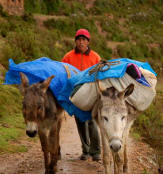
Photo by Dave Bezaire
La Paz, Tarija, Madidi National Park and Lake Titicaca were all very different experiences, but added up to a wonderful Global Village trip!

 Who
Who